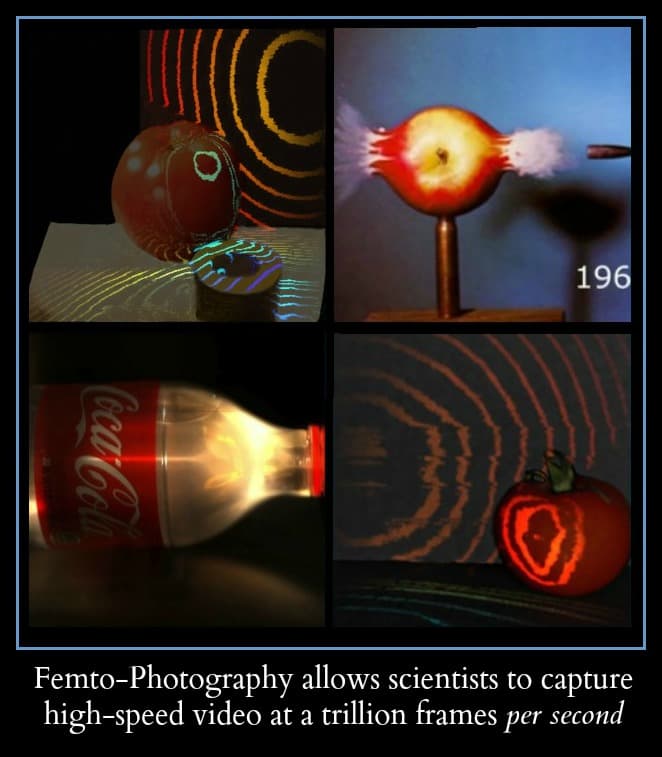Light in Action:
Have you ever wondered what light looks like as it moves? With a really cool new(ish) photography method called Femto-Photography, scientists are now able to take high-speed video at a trillion frames per second. This is so fast it allows us to watch groups of photons move across an object. In other words, just as high-speed cameras were able to slow down the bullet, revealing its mechanics and the processes that occur when it hits an apple or watermelon – now, using the magic of photography, we can slow down light, revealing its splendor.
So, what can you see when you take a picture every 13 nanoseconds? You can watch how photons interact with matter; the way photons are absorbed, the way they are reflected, even their physical affect on water as these photons cause little ripples to scatter about. You are even able to see the effects of relativity, as predicted by Einstein’s math, pulling back the cloak of the weird nature of an object as it travels at the speed of light.
This is the coolest video I have seen all year. I implore you to take 11-minutes out of your day and watch it. If you are unable to watch the whole video, you must watch the 1-minute-14-second segment between 2:54 and 3:28 – where you’ll witness a ‘bullet’ of photons travel through water in a coke bottle. To watch the shorter segment, you do not need volume (though, hearing Raskar’s talk will help enhance this experience).
Please, watch this video now or save it and make sure you watch it, in its entirety, later. It will be the best 11-minutes of your day, maybe even of your entire week.
So, it takes light:
- 18 milliseconds to travel between London and New York
- 0.13 seconds to circumnavigate the equator of the Earth
- 1.4 seconds to travel to the moon from Earth
- 8.4 minutes to travel from the Sun to the Earth
- 4.15 hours to travel from the Sun to Neptune, the most distant planet in our solar system
- 17 hours to travel to the current location of the Voyager 1 probe, which is the farthest man-made object in space
- 0.8 years to travel from the Earth to the Oort Cloud, which marks the boundary of our solar system
- 4.2 years to travel to Earth from Proxima Centauri, the nearest star from our Sun. (A planet was found orbiting one of the stars in the system last year)
- 100,000 years to travel across the entire span of the Milky Way galaxy
- 2.5 million years to travel to us from our closest neighbor, the Andromeda galaxy
- 11 billion years to travel to the newfound blob, one of the most distant structures in the universe.
Point being, light (photons, in particular) is super freaking fast -- The fastest traveling particle we know of, which makes Femto-Photography all the more impressive.
To see additional pictures, animations, and more information, visit here.
Share This Article
